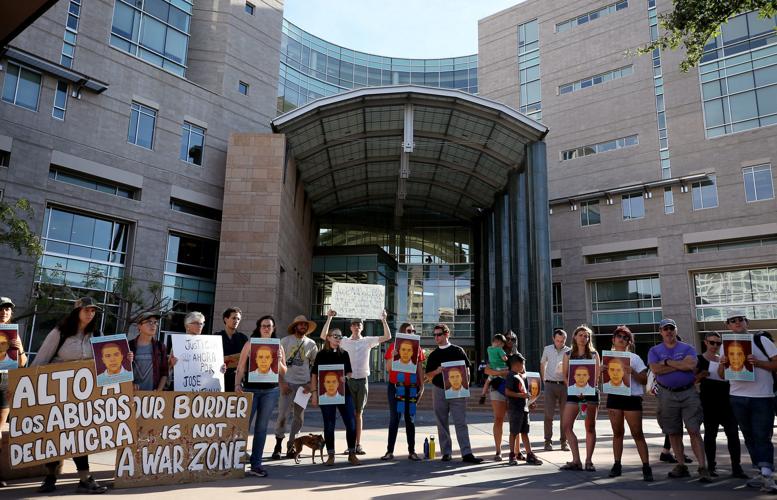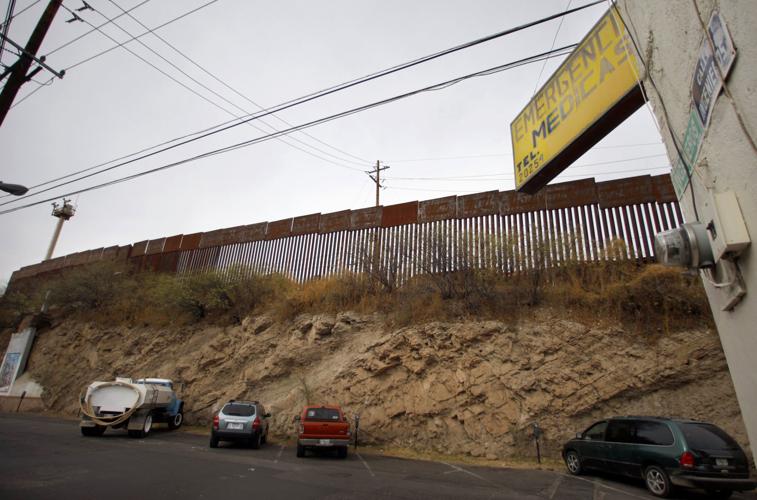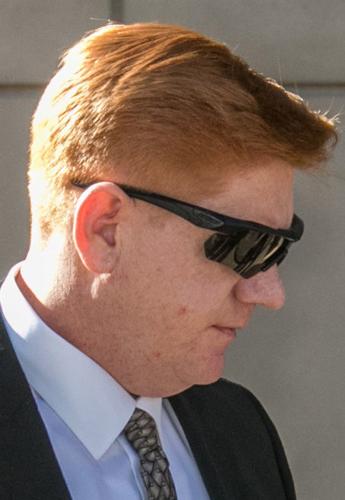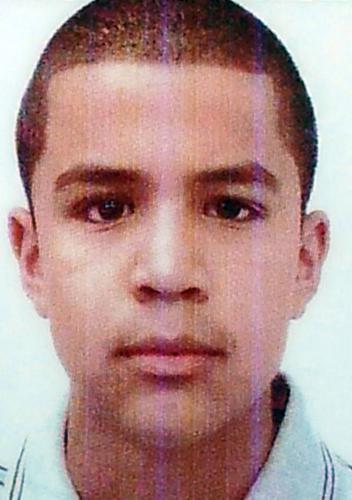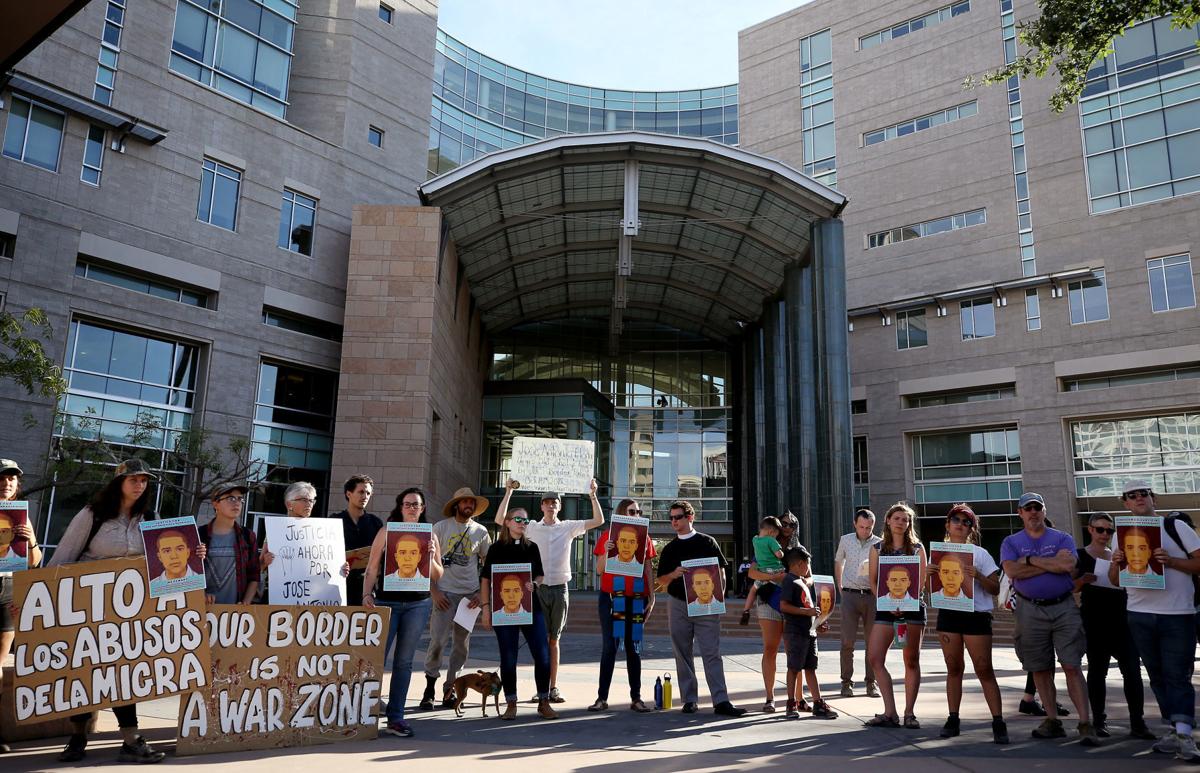Federal prosecutors will consider whether to retry Border Patrol agent Lonnie Swartz on lesser charges after a jury acquitted him Monday of second-degree murder in the 2012 death of a Mexican teen.
“We are very disappointed for the family, for the victim and for the community,” said Assistant U.S. Attorney Wallace Kleindienst outside the federal courtroom in Tucson after the verdict, which was followed by protests that blocked downtown streets into the night.
After nearly five days of deliberations, the jury of eight women and four men also told the judge it was hopelessly deadlocked on the two less-serious charges it was considering against Swartz, voluntary manslaughter or involuntary manslaughter.
Kleindienst said prosecutors will assess what was going through the jurors’ minds before deciding whether to retry Swartz on the manslaughter charges.
“It’s too soon to tell,” he said. “We all might be back here again.”
Swartz was charged in the October 2012 killing of 16-year-old Jose Antonio Elena Rodríguez of Nogales, Sonora. The agent is accused of firing 16 shots through the Nogales border fence in response to a group of rock throwers, including Elena Rodríguez, who was hit eight times in the back and twice in the head.

This is the area of Nogales, Sonora, where Jose Antonio Elena Rodríguez was shot by Border Patrol Agent Lonnie Swartz.
Defense attorneys said they were happy about the outcome “but we have to be humble about it, too” given the potentially pending criminal charges, said defense co-counsel Jim Calle.
A status conference for the case is scheduled for May 11.
U.S. District Court Judge Raner Collins instructed jurors to go to a separate room Monday after the verdict if they wanted to speak with journalists, but none did. As a result, nothing was made public about the jurors’ reasoning, which evidence they found most compelling or how many holdouts there were on lesser charges.
During the trial, however, the jurors had questions for most witnesses. They asked witnesses whether pieces of concrete shown to them could be part of larger pieces, alluding to the question of the size of the rocks being thrown at Swartz and other officers.
They also asked whether other agents and officers at the scene, who took cover and did not shoot, felt their lives were in danger. They also wanted to know whether a Nogales police officer there that night had taken his dog to the vet to confirm it wasn’t hit. Swartz testified he heard an agent say he had been hit and another tell the officer that his dog had been struck by a rock.
They also asked questions of Mexican investigators about evidence-gathering techniques and how they conducted the autopsy. The defense alleged missteps and flaws in the investigation on both sides of the border.
The jury also asked Swartz whether he would have used a less-lethal weapon if he had one, which Swartz had done in previous cases in which rocks were thrown. On the night he shot Elena Rodríguez, he didn’t have access to a pepper ball launcher or similar less-lethal weapons. He answered that he would have used one if he could have.
For the local chapter of the Border Patrol Union, the trial outcome was justice served.
While the prosecution said the case was not about whether Elena Rodríguez had been part of a smuggling operation that night, as argued by the defense, for Art del Cueto, president of the local chapter of the Border Patrol Union, that’s hard to separate.
“People were committing a crime and while they were committing a crime they attacked a federal agent. And what did the federal agent do? He defended himself and he defended other agents,” he said. “I get (that) the other agents didn’t feel they had to do that. ... OK, well let’s go to Florida.”
Del Cueto compared the incident on Oct. 10, 2012, with the recent shooting at a Parkland, Florida, high school where a sheriff’s deputy came under criticism for staying outside the school while a former student fatally shot 17 people.
“How can we prosecute Lonnie for doing the right thing? Lonnie did the right thing,” Del Cueto said.
The family of Elena Rodrìguez was not immediately available for comment. The family was escorted out of the courtroom after the judge communicated the jury’s decision.
Taide Elena, the teen’s grandmother and a Nogales, Arizona, resident, looked distraught.

Imelda Cortez, center, joined 15 other people wearing veils and holding candles to represent the 16 bullets that were fired at Mexican teenager Jose Antonio Elena Rodríguez.
About 100 protesters gathered in front of the courthouse after the verdict and blocked the intersection of West Congress Street and Granada Avenue for about 30 minutes. They carried signs saying “Stop the killings by Border Patrol,” “Demand justice for Jose Antonio Elena Rodriguez” and “End border militarization.”
Guadalupe Guerrero, mother of Carlos LaMadrid, 19, who was shot and killed by a Border Patrol agent in 2011 in Douglas, said she came to support Araceli Rodríguez, the mother of Elena Rodríguez. A federal judge in Tucson found the agent was not liable in LaMadrid’s death.
“My son has not received justice in this court. What is needed to find justice?” Guerrero asked the crowd as she sobbed and leaned against a traffic post. “Please help us! This cannot stay like this! My son was not an animal.”
A row of pebbles and candles was set up on the sidewalk nearby in memory of Elena Rodríguez.
The protesters began marching after rallying in front of the courthouse.
Several hours later, a group of protesters closed exit ramps from Interstate 10 near West Congress. The Arizona Department of Transportation said the protesters had blocked the off-ramps starting around 7:30 p.m. Tucson Police Department Sergeant Pete Dugan said there were no arrests, citations or injuries and that it was "very peaceful for the most part."
The defense and the prosecution rested their cases April 16, after about four weeks of testimony from agents and officers at the scene and by expert witnesses.
For prosecutors, the fact that Swartz fired 16 shots in 34 seconds, from three different locations and after reloading his pistol when Elena Rodríguez had fallen to the ground, showed he acted with “malice aforethought” or reckless disregard for human life. The government argued the teen was alive for most of the shots.
But the defense argued Swartz was justified in his use of force in response to a group of people throwing rocks from the Mexican side to help two alleged drug smugglers on top of the fence flee into Mexico. Smugglers are known to be armed and become combative if they need to protect a load, Swartz’s attorneys argued. The agent said he thought he was shooting at a second rock thrower when he continued to fire. Besides, they argued, the teen was killed from one of the first shots, making the rest legally irrelevant.
The size of the rocks, the distance between Swartz and the rock throwers (between 70 and 90 feet), the height of the fence and cliff the rocks had to clear (roughly 36 feet), the agents’ training when it comes to rocks and use of lethal force, and the fact that none of the other agents and officers shot at rock throwers became key arguments from both sides during the trial.
Besides Swartz, three Border Patrol agents have been criminally charged here since 1992. In all three previous cases, the agents were cleared.


